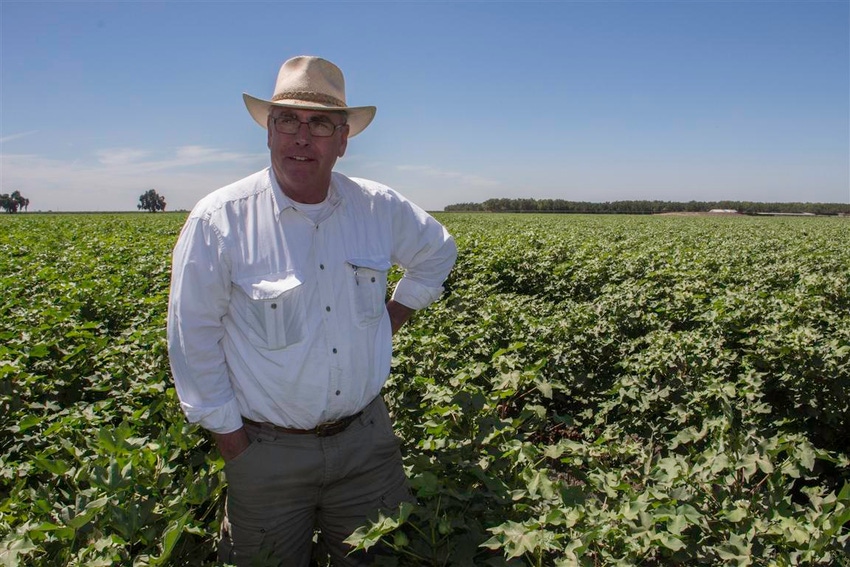
When it comes to California’s current cotton crop, the opinion in the field ranges from good to very good.
Good news indeed given the impact a sudden and intense heat spell in July had on the crop. Temperatures for a time exceeded 110 degrees Fahrenheit in California’s Central Valley which damaged some of the crop.
And now, rather than having his last irrigation behind him, Tulare grower Steve Wilbur is adding another costly irrigation to furrow flood his crop.
“Our final irrigation could have been right now,” said Steve Wilbur in early August.
Wilbur is a third generation grower and a partner in SBS Ag in Tulare with his son Blake Wilbur and son-in-law Sean Nicholson. Steve Wilbur is the first vice-chairman of the California Cotton Growers Association.
Water has been a significant factor in Wilbur’s farming operations this season. With no surface water deliveries from the Tulare Irrigation District (TID) for crops, SBS Ag and its neighbors have used well water to irrigate the crops. Many of the wells have dried up, a scene Wilbur has not seen in his 45 years of farming.
“I’ve run years where the Tulare Irrigation District had no ditch water, but we had higher water tables,” Wilbur said. “This year the water tables are very low.”
So low in fact that many of his neighbors, and even Wilbur, have seen wells dry up. At about $120,000 to drill and equip a well, most growers simply cannot afford to sink deeper into a depleted aquifer.
“We hear about neighbors’ wells failing or struggling on a weekly basis,” Wilbur said.
The good news for Wilbur is planting went well. He did not replant any fields. Couple that with no disease pressure on the 50 acres of Pima cotton and 270 acres of Upland cotton, plus no rain on the crop. Wilbur expects a decent harvest this season.
“Overall it looked pretty good until the heat spell in June and July which cooked the crop,” Wilbur said.
Kern County cotton
Kern County cotton grower Allen Pierucci’s cotton crop is pretty good.
Pierucci, the recipient of the 2010 Western Farm Press High Cotton award, farms 950 acres of cotton; about half Pima and half Upland Acala in the Buttonwillow area in Kern County, Calif.
“It wasn’t a cheap year to grow cotton,” Pierucci said.
A third-generation cotton grower, Pierucci is transitioning from cotton to permanent crops. He has 35 acres of pistachios in the ground and will plant the same amount next year. He plans to add 80 acres in 2015.
“We’re starting to diversify into pistachios,” he said. “We will still continue to grow some cotton.”
Like Wilbur’s operation located just north of him, water is also a big issue for Pierucci. Pest and other issues seem to be held in check this year.
“We’ll see how our crop did when we get it to the gin this year,” Pierucci said. “Until then I can’t say how we compare.”
Merced County cotton
At the northern end of California’s cotton growing region, Cannon Michael has about 3,000 acres of cotton in the Los Banos (Merced County) area. This is significantly down from the 5,000-plus acres planted just a year ago.
Michael is a sixth-generation grower with Bowles Farming Company in Los Banos and serves as chairman of the California Cotton Growers Association.
Michael predicts a good harvest from the crop of Acala and Hazera cotton. According to Michael, Hazera is an Israeli hybrid of cotton that blends well with Acala and Pima. Hazera also does well in the Los Banos area, where they have less heat units and the climate is generally a little cooler than the southern end of the San Joaquin Valley.
“The Hazera is a little shorter and not as strong as Pima,” Michael said. “Gins can blend this and get a better quality.”
Michael’s reduction in cotton acres was replaced with processing tomatoes and corn, both of which have improved prices this year. From a planting and harvesting standpoint, the corn and tomatoes use the same planters and row spacing.
Like other regions of California where water is scarce, keeping water on Michael’s crop has been a challenge.
“Where we are we have very good access to water because of our pre-1914 water rights,” Michael said. “But it’s still been a challenge due to the heat this summer.”
Pest pressure "spotty"
Pest pressures have been low in Michael’s cotton. Yet pest problems have not been light across the board, according to Peter Goodell, University of California IPM specialist. Goodell reports spotty insect problems throughout California cotton.
“We’ve seen a little more whitefly than in the past in some areas,” he said. “Lygus was also a bit of a problem early in some areas.”
According to Earl Williams, president and CEO of the California Cotton Ginners and Growers Associations, Fusarium Race 4 continues as a problem for the California cotton industry.
Statewide, Williams expects the cotton crop harvest to be 7-10 days ahead of normal.
Final pink bollworm survey acreage numbers recently came out in California. This year’s cotton crop could be about 280,000 acres of Pima and Upland cottons, down from about 365,000 last year, Williams says. Pima acreage accounts for about 190,000 acres, down from 225,000 acres last year.
“These numbers are less than we had hoped for, but given the water situation and continued competition from other crops including permanent plantings then we’ll take what we can get,” said Williams.
More stories from Western Farm Press
Parasitic wasp tapped to kill Asian Citrus Psyllid
Good agriculture and farming information is hard to find
Hahn's reinvents Central Coast wine-grape business
About the Author(s)
You May Also Like






